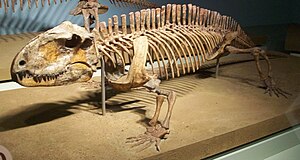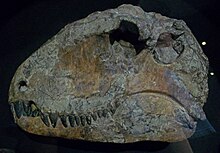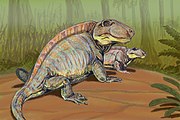Sphenacodon
| Sphenacodon | ||||||||||||
|---|---|---|---|---|---|---|---|---|---|---|---|---|

Skeletal reconstruction of Sphenacodon ferox at the Chicago Museum of Natural History |
||||||||||||
| Temporal occurrence | ||||||||||||
| Upper carbon to lower perm | ||||||||||||
| 300 to 270.6 million years | ||||||||||||
| Locations | ||||||||||||
| Systematics | ||||||||||||
|
||||||||||||
| Scientific name | ||||||||||||
| Sphenacodon | ||||||||||||
| Marsh , 1878 | ||||||||||||
| Art | ||||||||||||
|
||||||||||||
Sphenacodon ( Greek for "wedge tooth") is an extinct genus of synapsids from the late Carboniferous and early Permian with an age of approximately 300 to 270 million years. Like its close relative Dimetrodon , Sphenacodon was a carnivorous member of the Sphenacodontidae familyfromthe Eupelycosauria clade . Unlike Dimetrodon , Sphenacodon did not have a high dorsal sail, but a low crest that was formed from the elongated spinous processes of the vertebrae . Fossils of sphenacodon are from New Mexico and the border region of Utah and Arizona in North America known.
Two species are currently scientifically recognized: Sphenacodon ferox ( type species ) and Sphenacodon ferocior . Sphenacodon ferocior could reach a size of up to three meters and was 40 percent larger than Sphenacodon ferox , which could reach a length of about two meters. In addition, the dorsal (back) processes of Sphenacodon ferocior were proportionally up to 45 percent longer than those of Sphenacodon ferox . The recent discoveries of a nearly complete skull of Sphenacodon ferox have enabled further distinctions between the two species to be elucidated, such as the number of teeth in certain regions of the jaw and the size of the indentation between the maxilla and the intermaxillary bone . Both species appear together in some formations, but Sphenacodon ferox appears to have survived well into the early Permian.
description
The skull of Sphenacodon was very similar to that of Dimetrodon . It was narrow from side to side, but wider vertically. At the front part of the maxilla of the upper jaw , a recess was. The upper and lower jaws were equipped with a series of strong teeth, which were shaped into sharp incisors (precanine), large, dagger-like fangs (caniniform) and smaller molars (postcanine). The orbit was high and far back with a single temporal window behind and partially under the eye as characteristic of synapsids.
The body proportions were also similar to those of Dimetrodon : very large head, short neck, robust trunk and relatively short fore and hind limbs, as well as a tapered tail, which was about half the body length of the animal. However, Sphenacodon did not have the extremely elongated, cylindrical spinous processes and the back sail of more derived forms of the Sphenacodontiden such as Dimetrodon . Instead, Sphenacodon had only slightly elongated but flattened spinous processes, to which muscles were probably attached that enabled the predator to pounce powerfully on its prey. The sphenacodontid genus Ctenospondylus also had elongated spinous processes whose dorsal crest was higher than that of Sphenacodon , but not as high as that of Dimetrodon .
There are indications of a strong epaxial musculature along the base of the raised spinous processes in Sphenacodon . Most likely, these muscles were used to stiffen and strengthen the spine in locomotion and hunting prey by preventing meandering movements. A recent study on the structure of the vertebral processes of Sphenacodon confirms the assumption that the upper parts of the spinous processes were not enclosed by muscles, but protruded from the muscle layer and formed a low ridge. Finds of specimens in which postmortem curvatures of the body caused the appendages to overlap suggest that these were not connected to one another by hard or particularly firm tissue. The function of this low, skin-covered sphenacodon ridge is the subject of scientific debate. A thermoregulatory function appears unlikely, although the higher crest in Sphenacodon ferocior is allometrically larger than in Sphenacodon ferox . Recent studies favor an expressive function for the tall sails of Dimetrodon and Edaphosaurus .
In traditional depictions of both Sphenacodon and Dimetrodon , the short limbs of both genera showed splayed away from the body at an angle of 90 degrees, with the tail and belly of the animals dragging across the ground similar to that of modern lizards and crocodiles . Such an attitude is typical of the contemporary skeletal reconstructions of Sphenacodon in museums. Footprints from Dimetropus u. a. from Bromacker , which correspond to the foot position of large sphenacodontids and have no tail or belly prints, show, however, that the animals moved by holding their limbs under their bodies and walking in a narrow, semi-erect gait. Such clear indications of a more efficient straightened position suggest that important details about the anatomy and locomotion of Sphenacodon and other early pelycosaurs are not yet fully understood. Some well-preserved Dimetropus traces from the Prehistoric Trackways National Monument in New Mexico match the relatively small size of Sphenacodon , which is documented by fossil finds in the area. The traces can also come from another representative of the Sphenacodonts.
Sphenacodon and Dimetrodon are typically found in different geographic areas separated by the primeval Hueco Sea, which covered large areas of the equatorial Pangea (the southern part of modern-day Mexico ) during the early Permian . Sphenacodon is known from western New Mexico, Arizona and Utah, while Dimetrodon is mainly found from the delta regions of Texas and Oklahoma located to the east . The species Dimetrodon occidentalis was found in New Mexico. Each of the two genera represented the terrestrial top predator in its ecosystem and probably preyed on amphibians , diadectomorphs , as well as early synapsids and diapsids . Sphenacodon appears to have died out during the wolf camp around 280 million years ago . The genus Dimetrodon , however, survived until about 270 million years ago. Such large sphenacodontid predators were later superseded by the therapsids , the group of synapsids that included the direct ancestors of mammals .
Discovery history and classification
The American paleontologist Othniel Charles Marsh provided the first description of Sphenacodon in 1878 using a part of a lower jaw bone that had been found by the fossil collector David Baldwin in the Rotliegend region of northern New Mexico . The name "Sphenacodon" is made up of the ancient Greek σφήνη "wedge", ἀκή , "point" and ὀδούς "tooth". In his very brief description of the jawbone, Marsh cited the compressed crowns of the molars and their "very sharp incisors with no pinnacles" and concluded that the animal must have been about two meters long and was a carnivore, although the rest of the skeleton was unknown. He also made a sketch of the copy. Marsh provided the type species with the epithet ferox (wild) and created the family of Sphenacodontidae, which he added to the primitive reptile order “Rhynchocephala” ( Rhynchocephalia ). Then he summarized almost all groups of early reptiles as well as the more recent bridge lizards .
Other paleontologists ignored Marsh's brief mention of Sphenacodon for nearly three decades. Dimetrodon , which was also named by Marsh's rival Edward Drinker Cope in 1878 , became a scientifically important genus that was well documented by many finds. The recognition of Sphenacodon as a carnivorous pelycosaur with a low back crest, distinct from Dimetrodon , came about during the early 20th century when more fossils were found in New Mexico. The taxa Elcabrosaurus baldwini (Case, 1907) and Scoliomus (Williston and Case, 1913) proposed at that time are now regarded as junior synonyms of Sphenacodon ferox .
In 1937 Alfred Sherwood Romer described a second species from New Mexico, which he named Sphenacodon ferocior ("wilder") because it was larger, made a more robust impression and had longer spinous processes. Romer and Price (1940) provided detailed descriptions of both S. ferox and S. ferocior with skeletal reconstructions.
A third species, Sphenacodon britannicus , is sometimes mentioned in the literature. This was described in 1908 by the German paleontologist Friedrich von Huene as Oxyodon britannicus based on an upper jaw from England. However, the generic name Oxyodon (Baur, 1906) was already occupied by a species of fish and was therefore not valid for the species described. The specimen had previously been identified as a possible Triassic dinosaur , but v. Chicken recognized a pelycosaur. In 1974 the species was added to the genus Sphenacodon , with the indication that the specimen was approximately the size of Sphenacodon ferox . However, recent studies have raised the question of how far a distinction can be made between Dimetrodon , Sphenacodon or their own genus on the basis of such sparse fossil material . The species “ Oxyodon ” britannicus (or Sphenacodon (?) Britannicus ) is now generally classified as Sphenacodontidae incertae sedis .
Individual evidence
- ↑ a b c J. A. Spielmann, Rinehart, Larry F .; Lucas, Spencer G .; Berman, David S .; Henrici, Amy C .; Harris, Susan K .: Redescription of the cranial anatomy of Sphenacodon ferox Marsh (Eupelycosauria, Sphenacodontidae) from the Late Pennsylvanian-Early Permian of New Mexico . In: Bulletin. New Mexico Museum of Natural History and Science . 59, 2010, pp. 159-184.
- ↑ a b c A.S. Romer, and Price, LI: Review of the Pelycosauria . In: Geological Society of America Special Paper . 28, 1940, pp. 1-538.
- ↑ a b A. K. Huttenlocker, Rega, E. and Sumida, SS: Comparative anatomy and osteohistology of hyperelongate neural spines in the sphenacodontids Sphenacodon and Dimetrodon (Amniota: Synapsida) . In: Journal of Morphology . 271, 2010, pp. 1407-1421.
- ↑ AK Hutten Locker, Mazierski, D. and Reisz, RR: Comparative osteohistology of hyperelongate neural spines in the Edaphosauridae (Amniota: Synapsida) . In: Palaeontology . 54, 2011, pp. 573-590.
- ^ AP Hunt, Lucas, SG: Vertebrate tracks and the myth of the belly-dragging, tail-dragging tetrapods of the Late Paleozoic . In: Bulletin. New Mexico Museum of Natural History and Science . 271, 1998, pp. 67-69.
- ↑ SG Lucas: Traces of a Permian Seacoast. Prehistoric Trackways National Monument 2011, pp. 1-48.
- ↑ DS Berman: A New Species of Dimetrodon (Reptilia, Pelycosauria) from a Non-Deltaic Facies in the Lower Permian of North-Central New Mexico . In: Journal of Paleontology . 51 (1), 1977, pp. 108-115.
- ^ SG Lucas, Spielman, JA; Rinehart, LF; Martens, T .: Dimetrodon (Amniota: Synapsida: Sphenacodontidae) from the Lower Permian Abo Formation, Socorro County, New Mexico . In: New Mexico Geological Society Guidebook, 60th Field Conference, Geology of the Chupadera Mesa Region . 2009, pp. 281-284.
- ↑ Palmer, D. (Ed.): The Marshall Illustrated Encyclopedia of Dinosaurs and Prehistoric Animals . Marshall Editions, London 1999, ISBN 1-84028-152-9 , p. 187.
- ^ OC Marsh: Notice of new fossil reptiles . In: American Journal of Science . 3 (15), 1878, pp. 409-411.
- ^ EC Case: Revision of the Pelycosauria of North America . Carnegie Institution of Washington, Washington, DC 1907, pp. 1-176.
- ^ AS Romer: New genera and species of pelycosaurian reptiles . In: Proceedings of the New England Zoological Club . 16, 1937, pp. 89-96.
- ^ Fv Huene: New and misunderstood pelycosaurs: remnants from Europe . In: Centralblatt für Mineralogie, Geologie und Paläontologie . 14, 1908, pp. 431-434.
- ^ RL Paton: Lower Permian pelycosaurs from the English midlands . In: Palaeontology . 17, 1974, pp. 541-552.
- ^ DA Eberth: The skull of Sphenacodon ferocior , and comparisons with other sphenacodontines (Reptilia: Pelycosauria) . In: New Mexico Bureau of Mines and Mineral Resources, Circular . 90, 1985, pp. 1-40.




